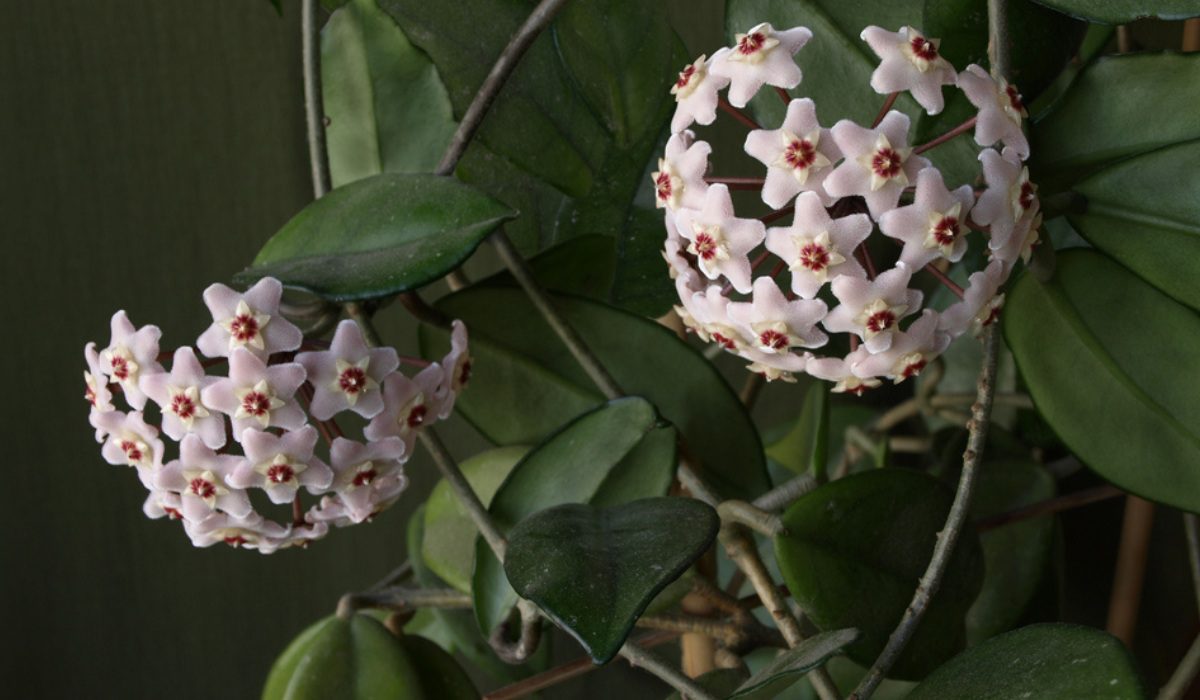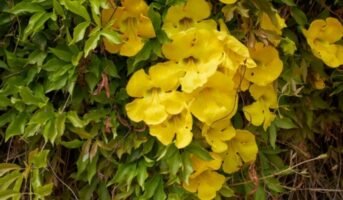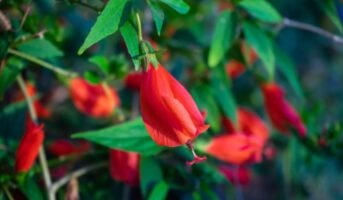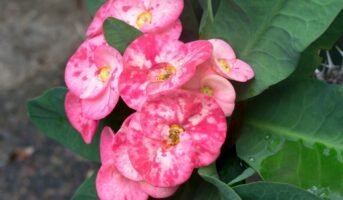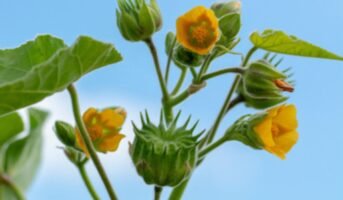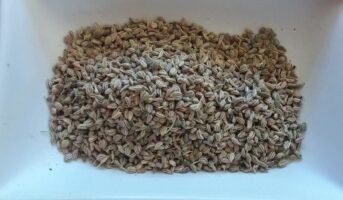Hoya Carnosa is one of the houseplants that adds a tropical feel to the home. Its aroma fills the house with a sweet, mesmerizing fragrance. It is also known as Honey plant or wax plant. Hoya Carnosa, the climbing plant, originated in Thailand.
In this modern era, when everyone is busy trying to prove their efficiency to outshine others in the competition, most individuals do not realize it. As a result, they are gripped by mental, emotional, and physical stress. An eye-catching, beautiful home interior can have a soothing effect not only on their mind and soul but also on the other family members. It could help overcome their stress by making them happy, forgetting everything for a moment.

Source: Pinterest
The refreshing beauty and aroma of Hoya Carnosa play a vital role in breaking the monotony of the traditional interior of the home and garden. It adds variety to our indoor and outdoor gardening and is commonly known as Honey Plant, Porcelain Flower, Wax Plant, etc. Additionally, these winning succulents have star-shaped flowers in clusters like a parachute. The color of the flower cluster varies from light pink to nearly white or even dark pink.

Source: Pinterest
It is an easy-to-grow decorative plant that needs comparatively less attention or care. It prefers less light but cannot grow in freezing temperatures. It can be cultivated through air layering or by stem propagation in the presence of indirect sunlight. The show plant has various medicinal benefits apart from its intoxicating aroma.
The potent antioxidant and antibacterial properties of the Hoya species call for their utilization in traditional Asian medicine. It has a range of medical uses and could be used to treat insect bites, wounds, skin inflammation, or bruises. It is used for skin treatments also. Further, to add to its glory, research shows that Hoya Carnosa can be an excellent remover of pollutants in the indoor environment. Let’s explore Hoya Carnosa, the facts about it, its benefits, propagation, etc.
Fact table of Hoya Carnosa
| Name of the Species | Hoya Carnosa |
| Family | Apocynaceae |
| Plant Type | Vining Succulent
Flowering Plant |
| Origin | Thailand |
| Distribution | Eastern Asia and Australia, Queensland, East India, Taiwan, Malaysia, Vietnam, etc |
| Common Names | Porcelain flower, Wax Plant, Honey Plant |
| Human Health | Antibacterial Properties
Antioxidant Properties Good for Skin treatments |
| Uses | Decorative Plant |
| Optimal Temperature | 60-85 degree Fahrenheit |
| Propagation | Seeds
Air layering By Stem Cutting |
| Season | Spring or Summer but there are some Autumn and Winter Bloomers |
| Maintenance | Low |
Propagation and care of the Porcelain flower
Hoya Carnosa grows and propagates well in indirect sunlight. However, it tolerates low light, which makes it best suited for an indoor decorative plant. Hoya Carnosa finds low light feasible for its growth but cannot grow at freezing temperatures.

Source: Pinterest
-
Propagation of Hoya Carnosa
The propagation of Hoya Carnosa is easier during summer or spring when the plant grows actively. It is their growing season, and they develop roots and grow faster than in winter when they sleep.
-
Pot propagation method
It propagates easily through stem cutting, by cutting a healthy stem bearing at least two or three leaves. The stem cut should be 4 to 5 inches long and planted in a well-drained potting mix, ensuring leaves should not touch the soil. Initially, watering is required regularly to keep the soil evenly moist.
-
Water propagation method
The second way of propagation of Hoya Carnosa could be in the water, simply by placing the Hoya plant in a jar of water, with leaves above the surface. The pot’s water can be regularly changed when it becomes murky, thus ensuring its healthy growth. Furthermore, once it develops roots, its progress can be easily monitored in water.
One should never forget that the best way to take a Hoya Carnosa cutting for propagation is by taking a few leaves and nodes. It is one of the determining factors that matter in their successful propagation.
-
Temperature for propagation of Hoya Carnosa
Hoya Carnosa can be easily cultivated. It can bear sunlight for many hours but not too much. The ideal temperature for the survival of the vining succulent is 60-85 degrees Fahrenheit, approximately 10 to 27 degrees Celsius but it could tolerate temperatures from 34 to 35 degrees Celsius. These plants with an alluring aroma do not like cold temperatures. Therefore, fertilizers are required only during summer and spring, once every three weeks or four weeks.
-
Fertilizers and soil for propagation of Hoya Carnosa
Hoya Carnosa is epiphytic and does not need heavy, more traditional soil. The wax plant is primarily a foliage plant. It requires nitrogen to speed up its growth. Therefore, the new plant should be provided with high-nitrogen fertilizers regularly. The high phosphorus fertilizer encourages blooming once the plant has attained a good size.
-
Protecting Hoya Carnosa from diseases and insects
Hoya Carnosa can sometimes be attacked by stem and root rot until symptoms are quite advanced. Then, it can be protected by the method of Cultural disease control. The significant pests for Hoya Carnosa species are aphids, mites, moths, scales, etc. The best way to control this problem is to avoid water supply and take measures to prevent algae growth. One of the most common diseases encountered in Hoya Carnosa is sooty mold, which can be easily overcome by just wiping off the mold with a damp cloth. A spray of diluted seaweed fertilizer can also be helpful.
Hoya Carnosa: Health benefits and medical uses
Hoya Carnosa, with its unique and gorgeous blooms, also bears medicinal health benefits. The oily soluble extract of the Porcelain Flower is used to treat many ailments. Its antioxidant and antibacterial properties make it useful in traditional medicines. In addition, it is used in skin treatment. The three naturally occurring compounds in the Hoya flower have been very useful in conventional medication and delivering glowing skin benefits.
Hoya Carnosa for home decor
Hoya Carnosa is a stunning plant perfect for growing in your home. This plant has a unique and striking appearance, with shiny green leaves and deep red stems that reach up to 3 inches tall.
Carnosa plants are commonly sold as houseplants, but they can also be used in an indoor garden or even in the landscape. Their large flowers attract hummingbirds, bees, butterflies, and other pollinators to the park. In addition, they have adapted well to different environments worldwide and will thrive in various climates.
Conclusion
The epiphytic Hoya Carnosa is a popular houseplant due to its intoxicating aroma and beautiful cluster of flowers. The sweetly-scented world of Hoya Carnosa has many benefits apart from its low maintenance. There are numerous health benefits this plant brings to everyone. It is also known as Hindu Rope Plant. The botanist Robert Brown, who classified it, called Hoya in honor of his friend Thomas Hoy.
FAQs
Is Hoya Carnosa toxic?
No, Hoya Carnosa is non-toxic for both humans and animals.
Can we grow Hoya Carnosa by water propagation?
Yes, we can grow Hoya Carnosa through water propagation.
Which is the best season for the fast growth of Hoya Carnosa?
Summer and Spring Seasons are the best for the fast growth of Hoya Carnosa.
Housing News Desk is the news desk of leading online real estate portal, Housing.com. Housing News Desk focuses on a variety of topics such as real estate laws, taxes, current news, property trends, home loans, rentals, décor, green homes, home improvement, etc. The main objective of the news desk, is to cover the real estate sector from the perspective of providing information that is useful to the end-user.
Facebook: https://www.facebook.com/housing.com/
Twitter: https://twitter.com/Housing
Email: [email protected]
